Child Development Assignment: Exploring Key Psychological Concepts
VerifiedAdded on 2021/04/16
|9
|2471
|48
Homework Assignment
AI Summary
This assignment delves into key psychological concepts related to child development. It begins by examining social learning theory, using the example of a child exhibiting aggressive behavior after observing wrestling matches, and explaining how children learn through observation and imitation, as ...
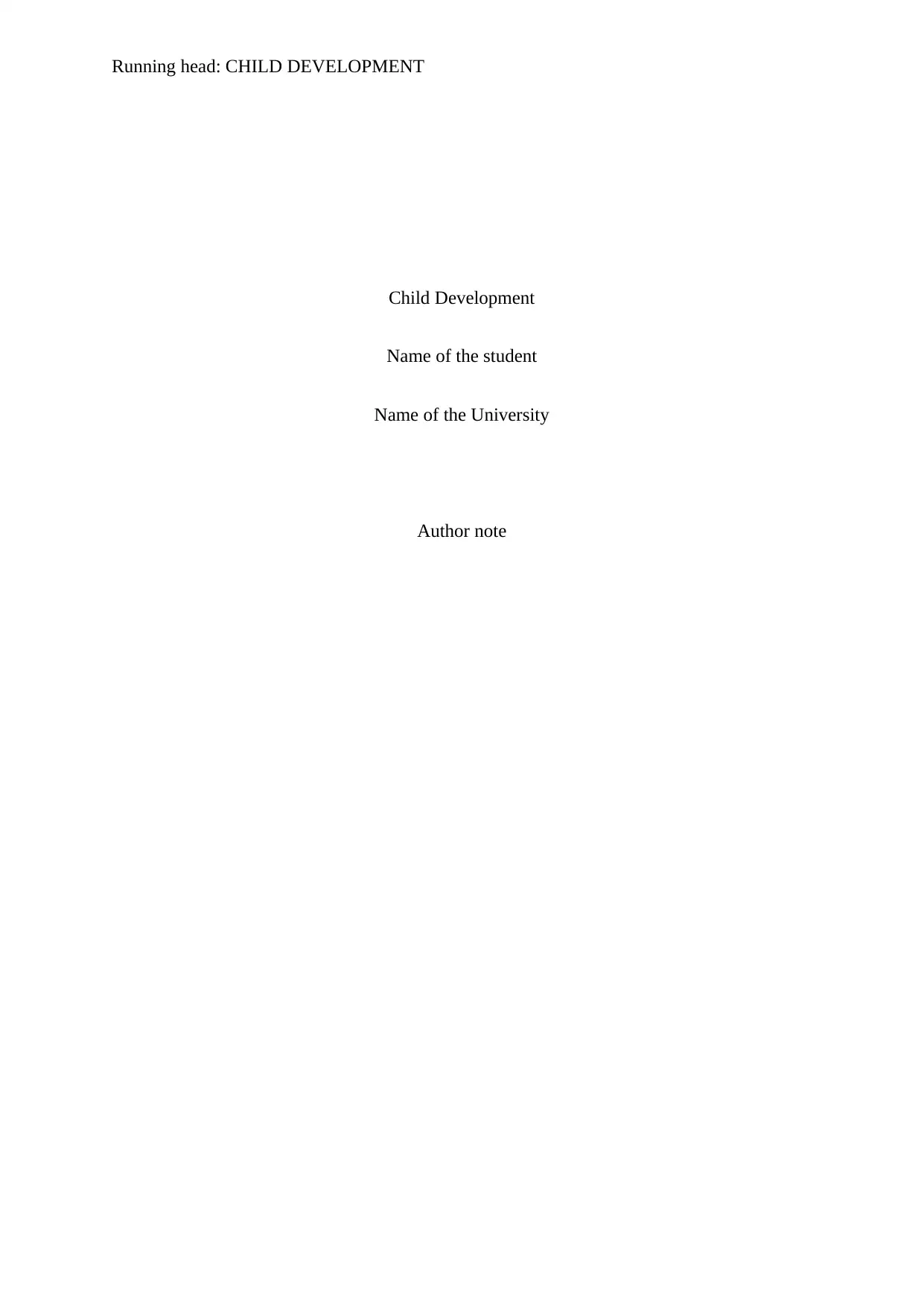
Running head: CHILD DEVELOPMENT
Child Development
Name of the student
Name of the University
Author note
Child Development
Name of the student
Name of the University
Author note
Paraphrase This Document
Need a fresh take? Get an instant paraphrase of this document with our AI Paraphraser
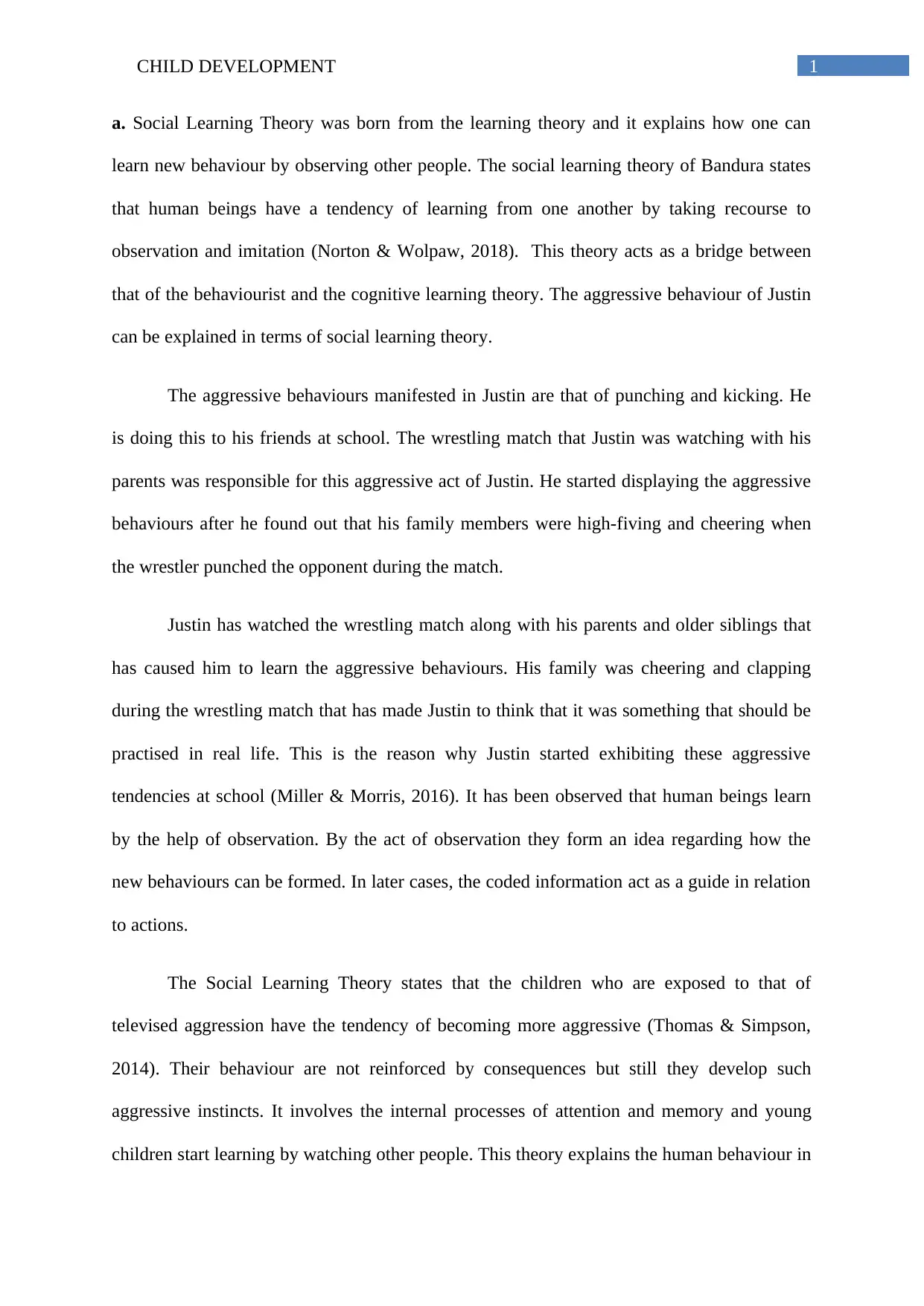
1CHILD DEVELOPMENT
a. Social Learning Theory was born from the learning theory and it explains how one can
learn new behaviour by observing other people. The social learning theory of Bandura states
that human beings have a tendency of learning from one another by taking recourse to
observation and imitation (Norton & Wolpaw, 2018). This theory acts as a bridge between
that of the behaviourist and the cognitive learning theory. The aggressive behaviour of Justin
can be explained in terms of social learning theory.
The aggressive behaviours manifested in Justin are that of punching and kicking. He
is doing this to his friends at school. The wrestling match that Justin was watching with his
parents was responsible for this aggressive act of Justin. He started displaying the aggressive
behaviours after he found out that his family members were high-fiving and cheering when
the wrestler punched the opponent during the match.
Justin has watched the wrestling match along with his parents and older siblings that
has caused him to learn the aggressive behaviours. His family was cheering and clapping
during the wrestling match that has made Justin to think that it was something that should be
practised in real life. This is the reason why Justin started exhibiting these aggressive
tendencies at school (Miller & Morris, 2016). It has been observed that human beings learn
by the help of observation. By the act of observation they form an idea regarding how the
new behaviours can be formed. In later cases, the coded information act as a guide in relation
to actions.
The Social Learning Theory states that the children who are exposed to that of
televised aggression have the tendency of becoming more aggressive (Thomas & Simpson,
2014). Their behaviour are not reinforced by consequences but still they develop such
aggressive instincts. It involves the internal processes of attention and memory and young
children start learning by watching other people. This theory explains the human behaviour in
a. Social Learning Theory was born from the learning theory and it explains how one can
learn new behaviour by observing other people. The social learning theory of Bandura states
that human beings have a tendency of learning from one another by taking recourse to
observation and imitation (Norton & Wolpaw, 2018). This theory acts as a bridge between
that of the behaviourist and the cognitive learning theory. The aggressive behaviour of Justin
can be explained in terms of social learning theory.
The aggressive behaviours manifested in Justin are that of punching and kicking. He
is doing this to his friends at school. The wrestling match that Justin was watching with his
parents was responsible for this aggressive act of Justin. He started displaying the aggressive
behaviours after he found out that his family members were high-fiving and cheering when
the wrestler punched the opponent during the match.
Justin has watched the wrestling match along with his parents and older siblings that
has caused him to learn the aggressive behaviours. His family was cheering and clapping
during the wrestling match that has made Justin to think that it was something that should be
practised in real life. This is the reason why Justin started exhibiting these aggressive
tendencies at school (Miller & Morris, 2016). It has been observed that human beings learn
by the help of observation. By the act of observation they form an idea regarding how the
new behaviours can be formed. In later cases, the coded information act as a guide in relation
to actions.
The Social Learning Theory states that the children who are exposed to that of
televised aggression have the tendency of becoming more aggressive (Thomas & Simpson,
2014). Their behaviour are not reinforced by consequences but still they develop such
aggressive instincts. It involves the internal processes of attention and memory and young
children start learning by watching other people. This theory explains the human behaviour in
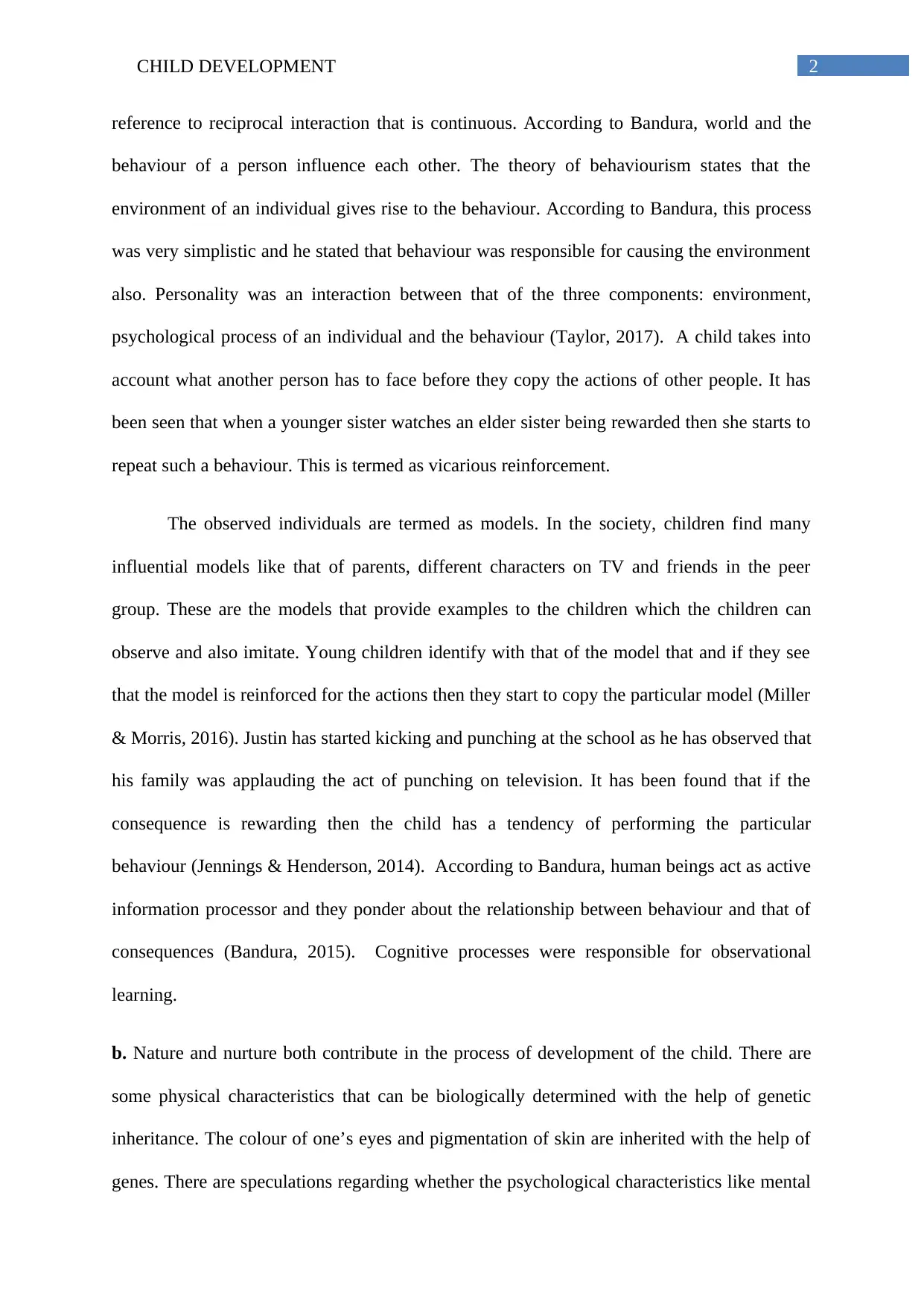
2CHILD DEVELOPMENT
reference to reciprocal interaction that is continuous. According to Bandura, world and the
behaviour of a person influence each other. The theory of behaviourism states that the
environment of an individual gives rise to the behaviour. According to Bandura, this process
was very simplistic and he stated that behaviour was responsible for causing the environment
also. Personality was an interaction between that of the three components: environment,
psychological process of an individual and the behaviour (Taylor, 2017). A child takes into
account what another person has to face before they copy the actions of other people. It has
been seen that when a younger sister watches an elder sister being rewarded then she starts to
repeat such a behaviour. This is termed as vicarious reinforcement.
The observed individuals are termed as models. In the society, children find many
influential models like that of parents, different characters on TV and friends in the peer
group. These are the models that provide examples to the children which the children can
observe and also imitate. Young children identify with that of the model that and if they see
that the model is reinforced for the actions then they start to copy the particular model (Miller
& Morris, 2016). Justin has started kicking and punching at the school as he has observed that
his family was applauding the act of punching on television. It has been found that if the
consequence is rewarding then the child has a tendency of performing the particular
behaviour (Jennings & Henderson, 2014). According to Bandura, human beings act as active
information processor and they ponder about the relationship between behaviour and that of
consequences (Bandura, 2015). Cognitive processes were responsible for observational
learning.
b. Nature and nurture both contribute in the process of development of the child. There are
some physical characteristics that can be biologically determined with the help of genetic
inheritance. The colour of one’s eyes and pigmentation of skin are inherited with the help of
genes. There are speculations regarding whether the psychological characteristics like mental
reference to reciprocal interaction that is continuous. According to Bandura, world and the
behaviour of a person influence each other. The theory of behaviourism states that the
environment of an individual gives rise to the behaviour. According to Bandura, this process
was very simplistic and he stated that behaviour was responsible for causing the environment
also. Personality was an interaction between that of the three components: environment,
psychological process of an individual and the behaviour (Taylor, 2017). A child takes into
account what another person has to face before they copy the actions of other people. It has
been seen that when a younger sister watches an elder sister being rewarded then she starts to
repeat such a behaviour. This is termed as vicarious reinforcement.
The observed individuals are termed as models. In the society, children find many
influential models like that of parents, different characters on TV and friends in the peer
group. These are the models that provide examples to the children which the children can
observe and also imitate. Young children identify with that of the model that and if they see
that the model is reinforced for the actions then they start to copy the particular model (Miller
& Morris, 2016). Justin has started kicking and punching at the school as he has observed that
his family was applauding the act of punching on television. It has been found that if the
consequence is rewarding then the child has a tendency of performing the particular
behaviour (Jennings & Henderson, 2014). According to Bandura, human beings act as active
information processor and they ponder about the relationship between behaviour and that of
consequences (Bandura, 2015). Cognitive processes were responsible for observational
learning.
b. Nature and nurture both contribute in the process of development of the child. There are
some physical characteristics that can be biologically determined with the help of genetic
inheritance. The colour of one’s eyes and pigmentation of skin are inherited with the help of
genes. There are speculations regarding whether the psychological characteristics like mental
⊘ This is a preview!⊘
Do you want full access?
Subscribe today to unlock all pages.

Trusted by 1+ million students worldwide
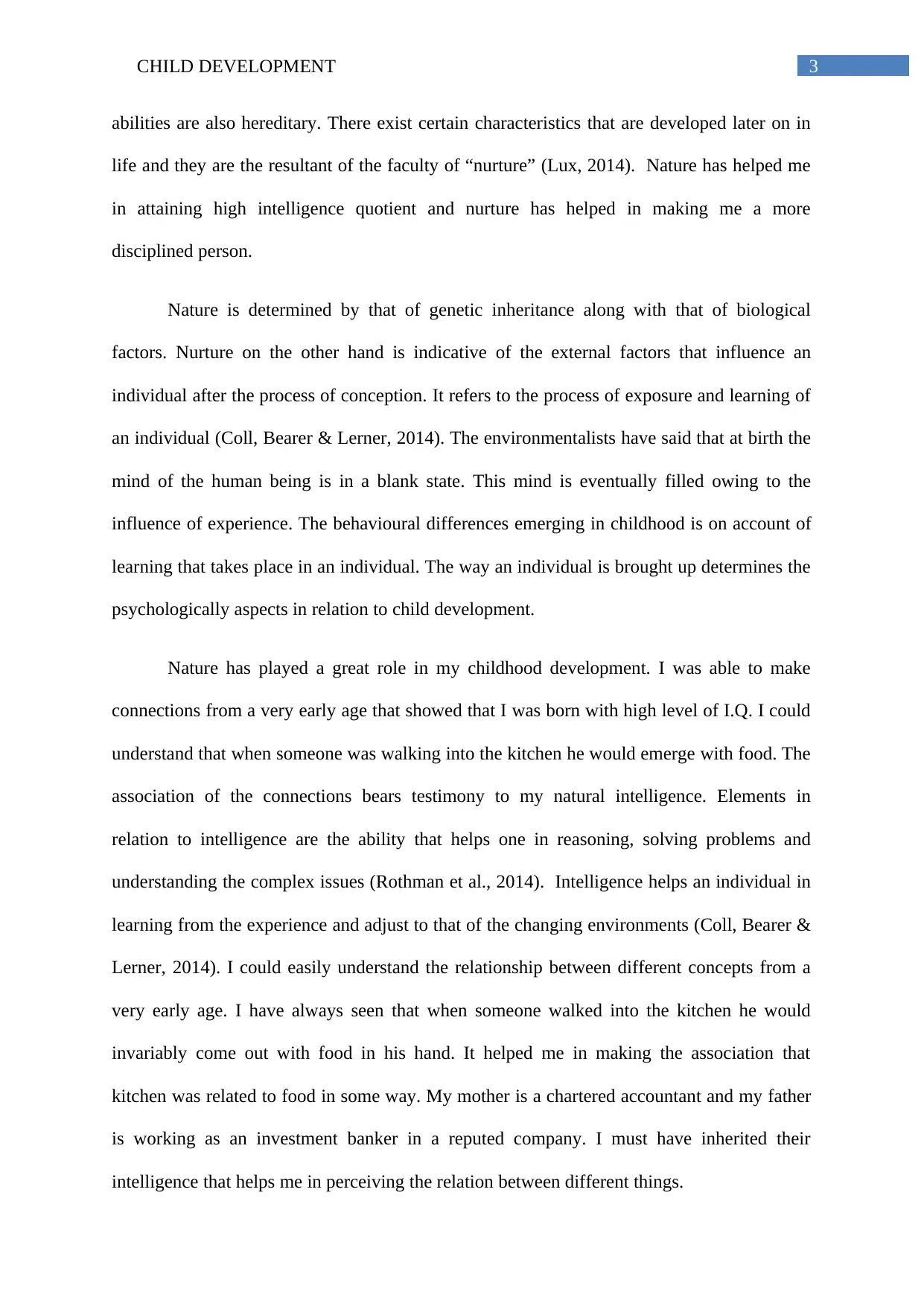
3CHILD DEVELOPMENT
abilities are also hereditary. There exist certain characteristics that are developed later on in
life and they are the resultant of the faculty of “nurture” (Lux, 2014). Nature has helped me
in attaining high intelligence quotient and nurture has helped in making me a more
disciplined person.
Nature is determined by that of genetic inheritance along with that of biological
factors. Nurture on the other hand is indicative of the external factors that influence an
individual after the process of conception. It refers to the process of exposure and learning of
an individual (Coll, Bearer & Lerner, 2014). The environmentalists have said that at birth the
mind of the human being is in a blank state. This mind is eventually filled owing to the
influence of experience. The behavioural differences emerging in childhood is on account of
learning that takes place in an individual. The way an individual is brought up determines the
psychologically aspects in relation to child development.
Nature has played a great role in my childhood development. I was able to make
connections from a very early age that showed that I was born with high level of I.Q. I could
understand that when someone was walking into the kitchen he would emerge with food. The
association of the connections bears testimony to my natural intelligence. Elements in
relation to intelligence are the ability that helps one in reasoning, solving problems and
understanding the complex issues (Rothman et al., 2014). Intelligence helps an individual in
learning from the experience and adjust to that of the changing environments (Coll, Bearer &
Lerner, 2014). I could easily understand the relationship between different concepts from a
very early age. I have always seen that when someone walked into the kitchen he would
invariably come out with food in his hand. It helped me in making the association that
kitchen was related to food in some way. My mother is a chartered accountant and my father
is working as an investment banker in a reputed company. I must have inherited their
intelligence that helps me in perceiving the relation between different things.
abilities are also hereditary. There exist certain characteristics that are developed later on in
life and they are the resultant of the faculty of “nurture” (Lux, 2014). Nature has helped me
in attaining high intelligence quotient and nurture has helped in making me a more
disciplined person.
Nature is determined by that of genetic inheritance along with that of biological
factors. Nurture on the other hand is indicative of the external factors that influence an
individual after the process of conception. It refers to the process of exposure and learning of
an individual (Coll, Bearer & Lerner, 2014). The environmentalists have said that at birth the
mind of the human being is in a blank state. This mind is eventually filled owing to the
influence of experience. The behavioural differences emerging in childhood is on account of
learning that takes place in an individual. The way an individual is brought up determines the
psychologically aspects in relation to child development.
Nature has played a great role in my childhood development. I was able to make
connections from a very early age that showed that I was born with high level of I.Q. I could
understand that when someone was walking into the kitchen he would emerge with food. The
association of the connections bears testimony to my natural intelligence. Elements in
relation to intelligence are the ability that helps one in reasoning, solving problems and
understanding the complex issues (Rothman et al., 2014). Intelligence helps an individual in
learning from the experience and adjust to that of the changing environments (Coll, Bearer &
Lerner, 2014). I could easily understand the relationship between different concepts from a
very early age. I have always seen that when someone walked into the kitchen he would
invariably come out with food in his hand. It helped me in making the association that
kitchen was related to food in some way. My mother is a chartered accountant and my father
is working as an investment banker in a reputed company. I must have inherited their
intelligence that helps me in perceiving the relation between different things.
Paraphrase This Document
Need a fresh take? Get an instant paraphrase of this document with our AI Paraphraser
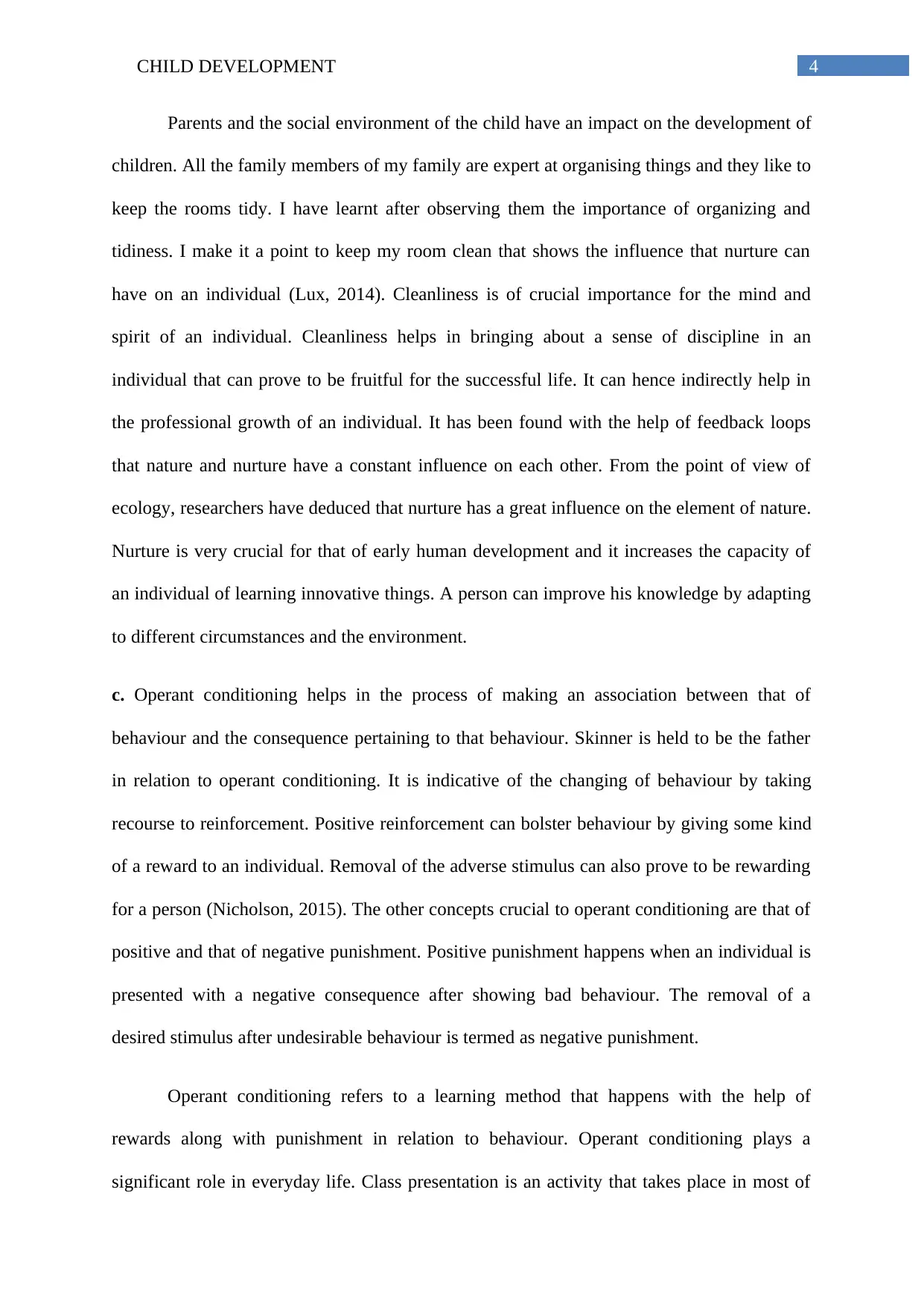
4CHILD DEVELOPMENT
Parents and the social environment of the child have an impact on the development of
children. All the family members of my family are expert at organising things and they like to
keep the rooms tidy. I have learnt after observing them the importance of organizing and
tidiness. I make it a point to keep my room clean that shows the influence that nurture can
have on an individual (Lux, 2014). Cleanliness is of crucial importance for the mind and
spirit of an individual. Cleanliness helps in bringing about a sense of discipline in an
individual that can prove to be fruitful for the successful life. It can hence indirectly help in
the professional growth of an individual. It has been found with the help of feedback loops
that nature and nurture have a constant influence on each other. From the point of view of
ecology, researchers have deduced that nurture has a great influence on the element of nature.
Nurture is very crucial for that of early human development and it increases the capacity of
an individual of learning innovative things. A person can improve his knowledge by adapting
to different circumstances and the environment.
c. Operant conditioning helps in the process of making an association between that of
behaviour and the consequence pertaining to that behaviour. Skinner is held to be the father
in relation to operant conditioning. It is indicative of the changing of behaviour by taking
recourse to reinforcement. Positive reinforcement can bolster behaviour by giving some kind
of a reward to an individual. Removal of the adverse stimulus can also prove to be rewarding
for a person (Nicholson, 2015). The other concepts crucial to operant conditioning are that of
positive and that of negative punishment. Positive punishment happens when an individual is
presented with a negative consequence after showing bad behaviour. The removal of a
desired stimulus after undesirable behaviour is termed as negative punishment.
Operant conditioning refers to a learning method that happens with the help of
rewards along with punishment in relation to behaviour. Operant conditioning plays a
significant role in everyday life. Class presentation is an activity that takes place in most of
Parents and the social environment of the child have an impact on the development of
children. All the family members of my family are expert at organising things and they like to
keep the rooms tidy. I have learnt after observing them the importance of organizing and
tidiness. I make it a point to keep my room clean that shows the influence that nurture can
have on an individual (Lux, 2014). Cleanliness is of crucial importance for the mind and
spirit of an individual. Cleanliness helps in bringing about a sense of discipline in an
individual that can prove to be fruitful for the successful life. It can hence indirectly help in
the professional growth of an individual. It has been found with the help of feedback loops
that nature and nurture have a constant influence on each other. From the point of view of
ecology, researchers have deduced that nurture has a great influence on the element of nature.
Nurture is very crucial for that of early human development and it increases the capacity of
an individual of learning innovative things. A person can improve his knowledge by adapting
to different circumstances and the environment.
c. Operant conditioning helps in the process of making an association between that of
behaviour and the consequence pertaining to that behaviour. Skinner is held to be the father
in relation to operant conditioning. It is indicative of the changing of behaviour by taking
recourse to reinforcement. Positive reinforcement can bolster behaviour by giving some kind
of a reward to an individual. Removal of the adverse stimulus can also prove to be rewarding
for a person (Nicholson, 2015). The other concepts crucial to operant conditioning are that of
positive and that of negative punishment. Positive punishment happens when an individual is
presented with a negative consequence after showing bad behaviour. The removal of a
desired stimulus after undesirable behaviour is termed as negative punishment.
Operant conditioning refers to a learning method that happens with the help of
rewards along with punishment in relation to behaviour. Operant conditioning plays a
significant role in everyday life. Class presentation is an activity that takes place in most of

5CHILD DEVELOPMENT
the schools. It is found that if the student is applauded then he becomes encouraged to give
similar presentations in the future. On the event of the student being criticized in the process
of delivering a presentation future presentation takes the shape of a formality (Blackman,
2017). The main concepts in relation to operant conditioning are that of positive
reinforcement and negative reinforcement. It is found that when a teacher compliments his
students when he gives the correct answer can help in increasing that kind of behaviour.
Negative reinforcement occurs when something that is unpleasant is taken away from a
person owing to acceptable behaviour (Nicholson, 2015). A teacher exempts the students
from that of the final test if the students have good attendance. This is an example of negative
reinforcement. It is found that when an employee shows bad behaviour at the workplace then
he is criticized by the boss. Bad behaviour will gradually decrease owing to the criticism.
This is an example of positive punishment. A child who always rides on the bike is punished
by the parents by the locking of the bike. The parents had taken the bike away so that it can
decrease the time that the child spends with the bike. This is an example of negative
punishment pertaining to operant conditioning (Pear, 2017).
With the help of operant conditioning, the right kind of behaviour can be shaped. It
can help in shaping the attitude and customs. Positive reinforcement can help in bringing
about great effects on that of the behaviour of the child. Parental attention and that of verbal
encouragement can are useful tools that can enhance the desirable behaviour of an infant
(Eaton, Libey & Fetz, 2016). Children need the emotional support of their parents so that
they can develop the different domains. It is natural that when the infant will spend more time
behaving in a desirable manner he will eventually end up behaving less undesirably.
Operant conditioning highlights that reward given for good behaviour can help in the
development of the child. In the similar strain punishment given for bad behaviour can help
in curbing the negative tendencies of the child. It is found that if the child is offered an ice
the schools. It is found that if the student is applauded then he becomes encouraged to give
similar presentations in the future. On the event of the student being criticized in the process
of delivering a presentation future presentation takes the shape of a formality (Blackman,
2017). The main concepts in relation to operant conditioning are that of positive
reinforcement and negative reinforcement. It is found that when a teacher compliments his
students when he gives the correct answer can help in increasing that kind of behaviour.
Negative reinforcement occurs when something that is unpleasant is taken away from a
person owing to acceptable behaviour (Nicholson, 2015). A teacher exempts the students
from that of the final test if the students have good attendance. This is an example of negative
reinforcement. It is found that when an employee shows bad behaviour at the workplace then
he is criticized by the boss. Bad behaviour will gradually decrease owing to the criticism.
This is an example of positive punishment. A child who always rides on the bike is punished
by the parents by the locking of the bike. The parents had taken the bike away so that it can
decrease the time that the child spends with the bike. This is an example of negative
punishment pertaining to operant conditioning (Pear, 2017).
With the help of operant conditioning, the right kind of behaviour can be shaped. It
can help in shaping the attitude and customs. Positive reinforcement can help in bringing
about great effects on that of the behaviour of the child. Parental attention and that of verbal
encouragement can are useful tools that can enhance the desirable behaviour of an infant
(Eaton, Libey & Fetz, 2016). Children need the emotional support of their parents so that
they can develop the different domains. It is natural that when the infant will spend more time
behaving in a desirable manner he will eventually end up behaving less undesirably.
Operant conditioning highlights that reward given for good behaviour can help in the
development of the child. In the similar strain punishment given for bad behaviour can help
in curbing the negative tendencies of the child. It is found that if the child is offered an ice
⊘ This is a preview!⊘
Do you want full access?
Subscribe today to unlock all pages.

Trusted by 1+ million students worldwide
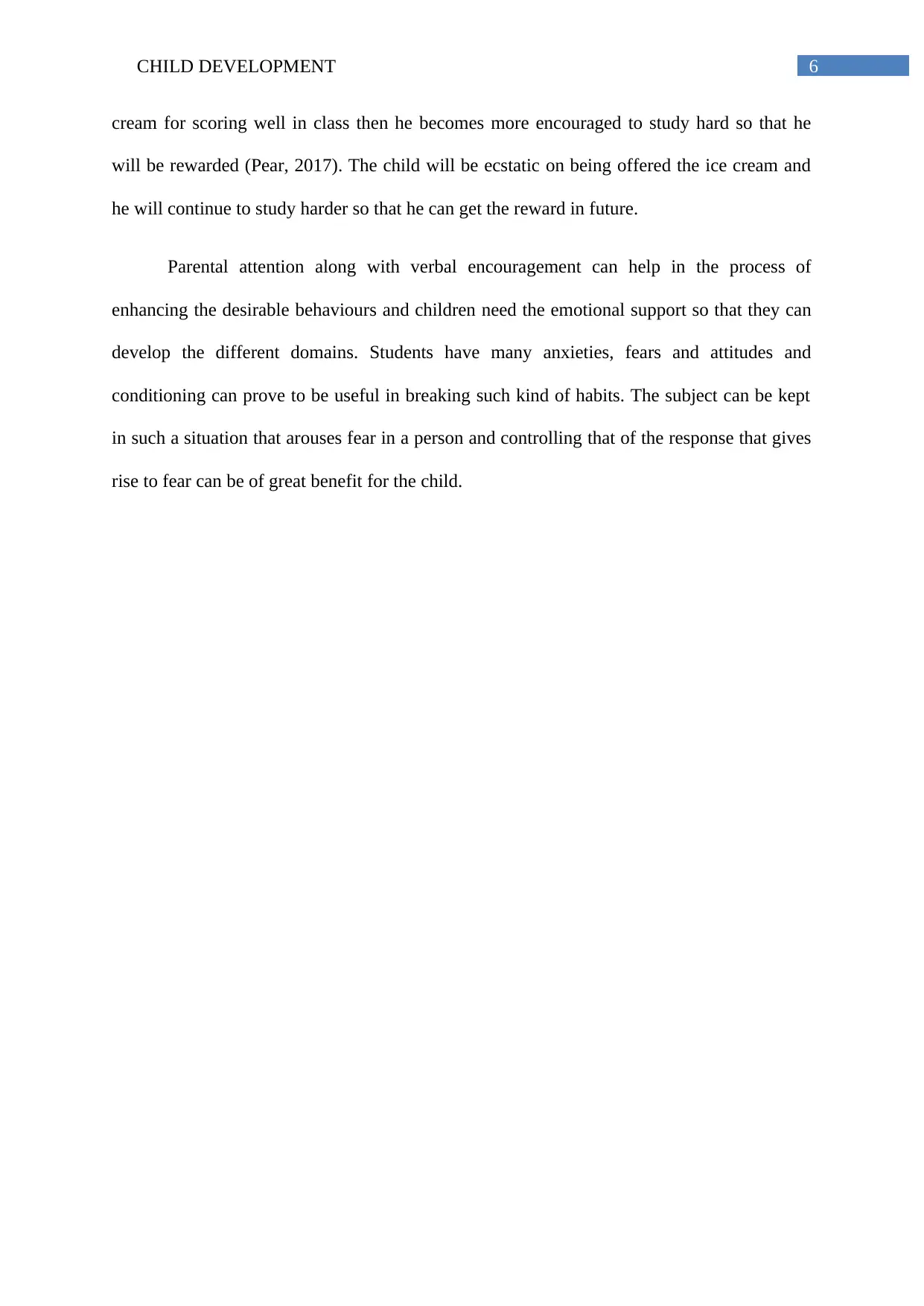
6CHILD DEVELOPMENT
cream for scoring well in class then he becomes more encouraged to study hard so that he
will be rewarded (Pear, 2017). The child will be ecstatic on being offered the ice cream and
he will continue to study harder so that he can get the reward in future.
Parental attention along with verbal encouragement can help in the process of
enhancing the desirable behaviours and children need the emotional support so that they can
develop the different domains. Students have many anxieties, fears and attitudes and
conditioning can prove to be useful in breaking such kind of habits. The subject can be kept
in such a situation that arouses fear in a person and controlling that of the response that gives
rise to fear can be of great benefit for the child.
cream for scoring well in class then he becomes more encouraged to study hard so that he
will be rewarded (Pear, 2017). The child will be ecstatic on being offered the ice cream and
he will continue to study harder so that he can get the reward in future.
Parental attention along with verbal encouragement can help in the process of
enhancing the desirable behaviours and children need the emotional support so that they can
develop the different domains. Students have many anxieties, fears and attitudes and
conditioning can prove to be useful in breaking such kind of habits. The subject can be kept
in such a situation that arouses fear in a person and controlling that of the response that gives
rise to fear can be of great benefit for the child.
Paraphrase This Document
Need a fresh take? Get an instant paraphrase of this document with our AI Paraphraser
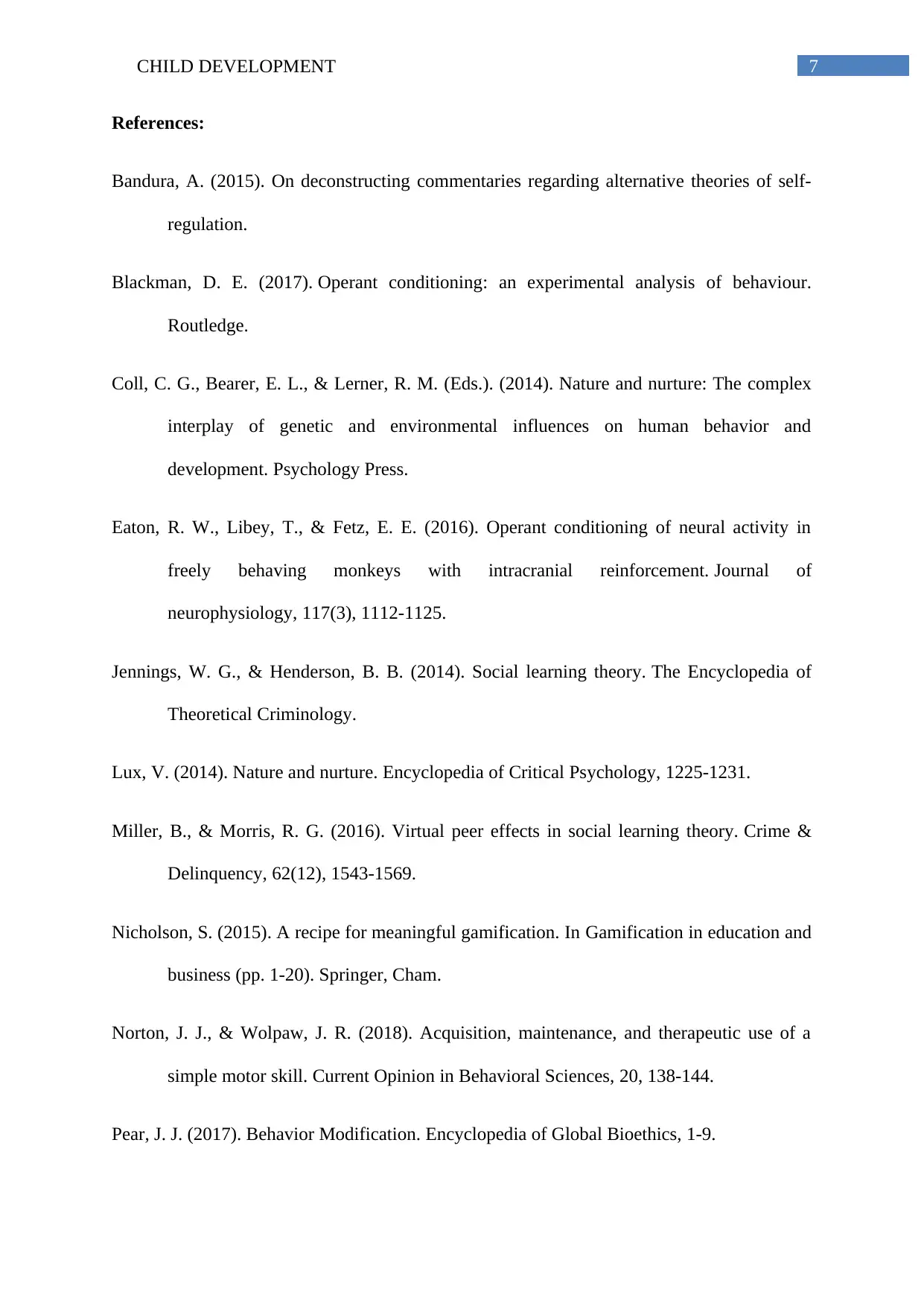
7CHILD DEVELOPMENT
References:
Bandura, A. (2015). On deconstructing commentaries regarding alternative theories of self-
regulation.
Blackman, D. E. (2017). Operant conditioning: an experimental analysis of behaviour.
Routledge.
Coll, C. G., Bearer, E. L., & Lerner, R. M. (Eds.). (2014). Nature and nurture: The complex
interplay of genetic and environmental influences on human behavior and
development. Psychology Press.
Eaton, R. W., Libey, T., & Fetz, E. E. (2016). Operant conditioning of neural activity in
freely behaving monkeys with intracranial reinforcement. Journal of
neurophysiology, 117(3), 1112-1125.
Jennings, W. G., & Henderson, B. B. (2014). Social learning theory. The Encyclopedia of
Theoretical Criminology.
Lux, V. (2014). Nature and nurture. Encyclopedia of Critical Psychology, 1225-1231.
Miller, B., & Morris, R. G. (2016). Virtual peer effects in social learning theory. Crime &
Delinquency, 62(12), 1543-1569.
Nicholson, S. (2015). A recipe for meaningful gamification. In Gamification in education and
business (pp. 1-20). Springer, Cham.
Norton, J. J., & Wolpaw, J. R. (2018). Acquisition, maintenance, and therapeutic use of a
simple motor skill. Current Opinion in Behavioral Sciences, 20, 138-144.
Pear, J. J. (2017). Behavior Modification. Encyclopedia of Global Bioethics, 1-9.
References:
Bandura, A. (2015). On deconstructing commentaries regarding alternative theories of self-
regulation.
Blackman, D. E. (2017). Operant conditioning: an experimental analysis of behaviour.
Routledge.
Coll, C. G., Bearer, E. L., & Lerner, R. M. (Eds.). (2014). Nature and nurture: The complex
interplay of genetic and environmental influences on human behavior and
development. Psychology Press.
Eaton, R. W., Libey, T., & Fetz, E. E. (2016). Operant conditioning of neural activity in
freely behaving monkeys with intracranial reinforcement. Journal of
neurophysiology, 117(3), 1112-1125.
Jennings, W. G., & Henderson, B. B. (2014). Social learning theory. The Encyclopedia of
Theoretical Criminology.
Lux, V. (2014). Nature and nurture. Encyclopedia of Critical Psychology, 1225-1231.
Miller, B., & Morris, R. G. (2016). Virtual peer effects in social learning theory. Crime &
Delinquency, 62(12), 1543-1569.
Nicholson, S. (2015). A recipe for meaningful gamification. In Gamification in education and
business (pp. 1-20). Springer, Cham.
Norton, J. J., & Wolpaw, J. R. (2018). Acquisition, maintenance, and therapeutic use of a
simple motor skill. Current Opinion in Behavioral Sciences, 20, 138-144.
Pear, J. J. (2017). Behavior Modification. Encyclopedia of Global Bioethics, 1-9.
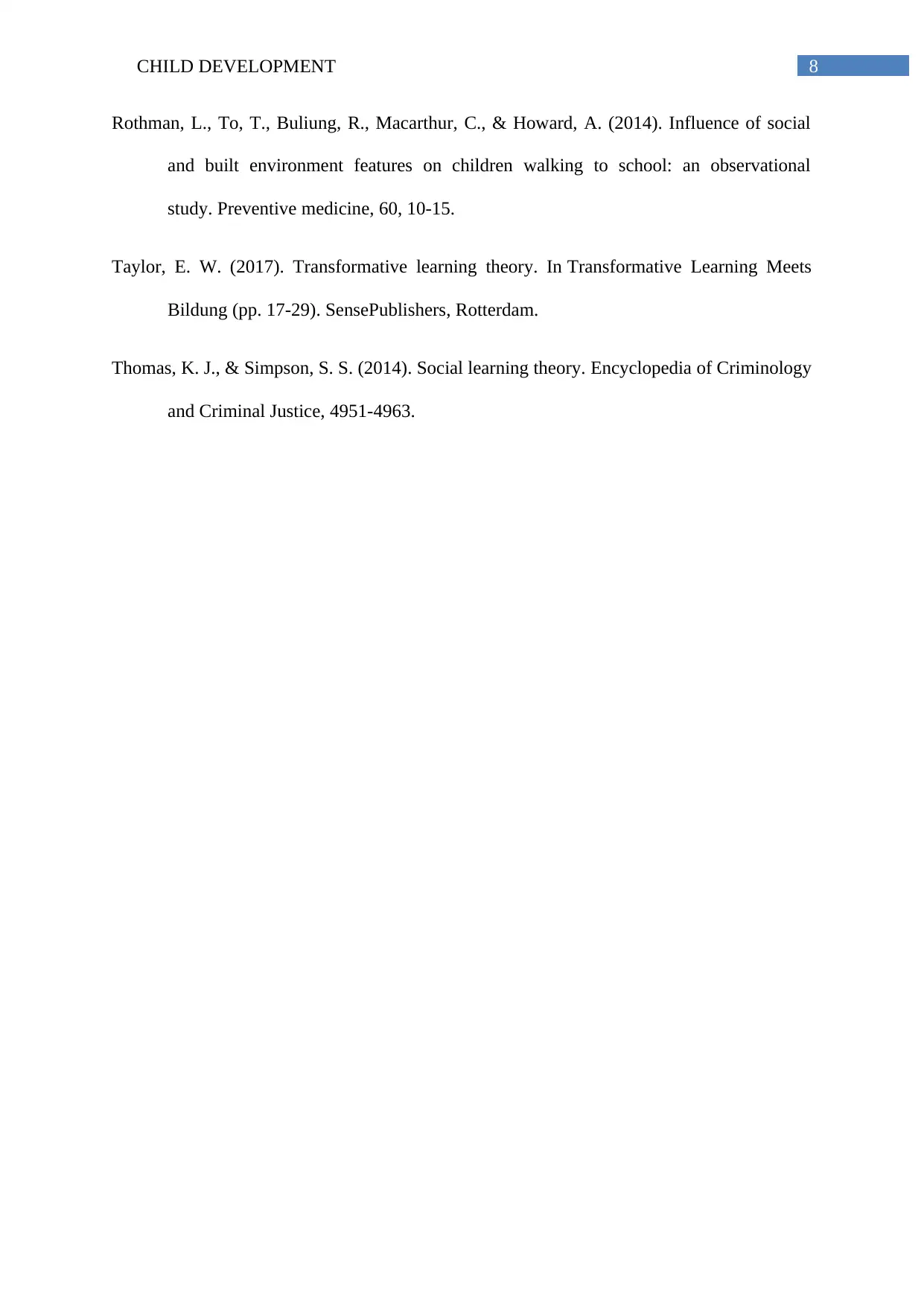
8CHILD DEVELOPMENT
Rothman, L., To, T., Buliung, R., Macarthur, C., & Howard, A. (2014). Influence of social
and built environment features on children walking to school: an observational
study. Preventive medicine, 60, 10-15.
Taylor, E. W. (2017). Transformative learning theory. In Transformative Learning Meets
Bildung (pp. 17-29). SensePublishers, Rotterdam.
Thomas, K. J., & Simpson, S. S. (2014). Social learning theory. Encyclopedia of Criminology
and Criminal Justice, 4951-4963.
Rothman, L., To, T., Buliung, R., Macarthur, C., & Howard, A. (2014). Influence of social
and built environment features on children walking to school: an observational
study. Preventive medicine, 60, 10-15.
Taylor, E. W. (2017). Transformative learning theory. In Transformative Learning Meets
Bildung (pp. 17-29). SensePublishers, Rotterdam.
Thomas, K. J., & Simpson, S. S. (2014). Social learning theory. Encyclopedia of Criminology
and Criminal Justice, 4951-4963.
⊘ This is a preview!⊘
Do you want full access?
Subscribe today to unlock all pages.

Trusted by 1+ million students worldwide
1 out of 9
Related Documents
Your All-in-One AI-Powered Toolkit for Academic Success.
+13062052269
info@desklib.com
Available 24*7 on WhatsApp / Email
![[object Object]](/_next/static/media/star-bottom.7253800d.svg)
Unlock your academic potential
© 2024 | Zucol Services PVT LTD | All rights reserved.





